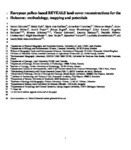European pollen-based REVEALS land-cover reconstructions for the Holocene: methodology, mapping and potentials
| dc.contributor.author | Githumbi, E | |
| dc.contributor.author | Fyfe, R | |
| dc.contributor.author | Gaillard, M-J | |
| dc.contributor.author | Trondman, A-K | |
| dc.contributor.author | Mazier, F | |
| dc.contributor.author | Nielsen, A-B | |
| dc.contributor.author | Poska, A | |
| dc.contributor.author | Sugita, S | |
| dc.contributor.author | Woodbridge, Jessie | |
| dc.contributor.author | Azuara, J | |
| dc.contributor.author | Feurdean, A | |
| dc.contributor.author | Grindean, R | |
| dc.contributor.author | Lebreton, V | |
| dc.contributor.author | Marquer, L | |
| dc.contributor.author | Nebout-Combourieu, N | |
| dc.contributor.author | Stančikaitė, M | |
| dc.contributor.author | Tanţău, I | |
| dc.contributor.author | Tonkov, S | |
| dc.contributor.author | Shumilovskikh, L | |
| dc.date.accessioned | 2022-04-08T09:28:40Z | |
| dc.date.available | 2022-04-08T09:28:40Z | |
| dc.date.issued | 2022-04-08 | |
| dc.identifier.issn | 1866-3508 | |
| dc.identifier.issn | 1866-3516 | |
| dc.identifier.uri | http://hdl.handle.net/10026.1/19022 | |
| dc.description.abstract |
<jats:p>Abstract. Quantitative reconstructions of past land cover are necessary to determine the processes involved in climate–human–land-cover interactions. We present the first temporally continuous and most spatially extensive pollen-based land-cover reconstruction for Europe over the Holocene (last 11 700 cal yr BP). We describe how vegetation cover has been quantified from pollen records at a 1∘ × 1∘ spatial scale using the “Regional Estimates of VEgetation Abundance from Large Sites” (REVEALS) model. REVEALS calculates estimates of past regional vegetation cover in proportions or percentages. REVEALS has been applied to 1128 pollen records across Europe and part of the eastern Mediterranean–Black Sea–Caspian corridor (30–75∘ N, 25∘ W–50∘ E) to reconstruct the percentage cover of 31 plant taxa assigned to 12 plant functional types (PFTs) and 3 land-cover types (LCTs). A new synthesis of relative pollen productivities (RPPs) for European plant taxa was performed for this reconstruction. It includes multiple RPP values (≥2 values) for 39 taxa and single values for 15 taxa (total of 54 taxa). To illustrate this, we present distribution maps for five taxa (Calluna vulgaris, Cerealia type (t)., Picea abies, deciduous Quercus t. and evergreen Quercus t.) and three land-cover types (open land, OL; evergreen trees, ETs; and summer-green trees, STs) for eight selected time windows. The reliability of the REVEALS reconstructions and issues related to the interpretation of the results in terms of landscape openness and human-induced vegetation change are discussed. This is followed by a review of the current use of this reconstruction and its future potential utility and development. REVEALS data quality are primarily determined by pollen count data (pollen count and sample, pollen identification, and chronology) and site type and number (lake or bog, large or small, one site vs. multiple sites) used for REVEALS analysis (for each grid cell). A large number of sites with high-quality pollen count data will produce more reliable land-cover estimates with lower standard errors compared to a low number of sites with lower-quality pollen count data. The REVEALS data presented here can be downloaded from https://doi.org/10.1594/PANGAEA.937075 (Fyfe et al., 2022). </jats:p> | |
| dc.format.extent | 1581-1619 | |
| dc.language | en | |
| dc.language.iso | en | |
| dc.publisher | Copernicus Publications | |
| dc.title | European pollen-based REVEALS land-cover reconstructions for the Holocene: methodology, mapping and potentials | |
| dc.type | journal-article | |
| dc.type | Journal | |
| plymouth.author-url | https://www.webofscience.com/api/gateway?GWVersion=2&SrcApp=PARTNER_APP&SrcAuth=LinksAMR&KeyUT=WOS:000792377000001&DestLinkType=FullRecord&DestApp=ALL_WOS&UsrCustomerID=11bb513d99f797142bcfeffcc58ea008 | |
| plymouth.issue | 4 | |
| plymouth.volume | 14 | |
| plymouth.publication-status | Published online | |
| plymouth.journal | Earth System Science Data | |
| dc.identifier.doi | 10.5194/essd-14-1581-2022 | |
| plymouth.organisational-group | /Plymouth | |
| plymouth.organisational-group | /Plymouth/Admin Group - REF | |
| plymouth.organisational-group | /Plymouth/Admin Group - REF/REF Admin Group - FoSE | |
| plymouth.organisational-group | /Plymouth/Faculty of Science and Engineering | |
| plymouth.organisational-group | /Plymouth/Faculty of Science and Engineering/School of Geography, Earth and Environmental Sciences | |
| plymouth.organisational-group | /Plymouth/REF 2021 Researchers by UoA | |
| plymouth.organisational-group | /Plymouth/REF 2021 Researchers by UoA/UoA14 Geography and Environmental Studies | |
| plymouth.organisational-group | /Plymouth/Research Groups | |
| plymouth.organisational-group | /Plymouth/Research Groups/Marine Institute | |
| plymouth.organisational-group | /Plymouth/Users by role | |
| plymouth.organisational-group | /Plymouth/Users by role/Academics | |
| dcterms.dateAccepted | 2022-02-25 | |
| dc.rights.embargodate | 2022-4-9 | |
| dc.identifier.eissn | 1866-3516 | |
| dc.rights.embargoperiod | Not known | |
| rioxxterms.versionofrecord | 10.5194/essd-14-1581-2022 | |
| rioxxterms.licenseref.uri | http://www.rioxx.net/licenses/all-rights-reserved | |
| rioxxterms.licenseref.startdate | 2022-04-08 | |
| rioxxterms.type | Journal Article/Review |


